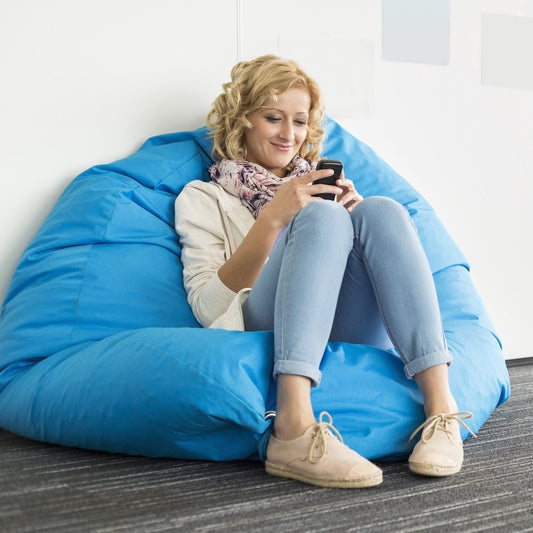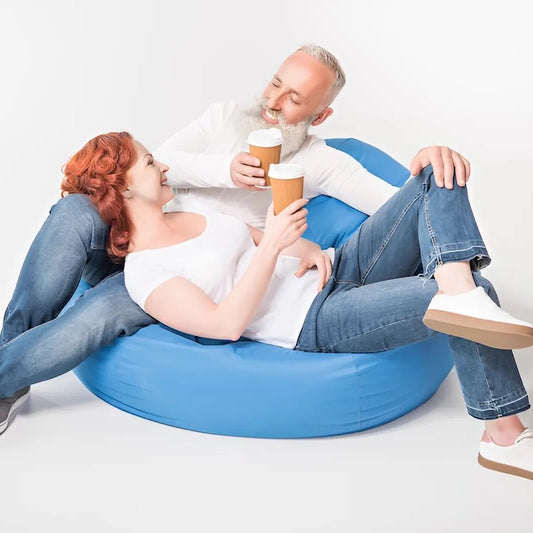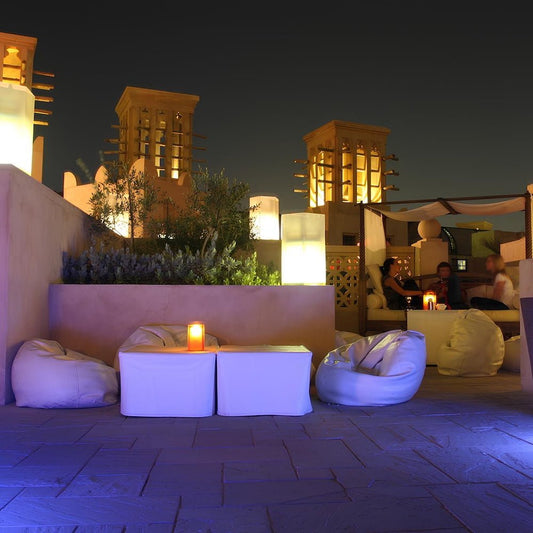There is a range of different options when choosing thread to use for outdoor fabric. The most common types include nylon, polyester, and PTFE. These are the standard materials for outdoor cushions, outdoor beanbags and pool beanbags. These share similar qualities. But they also have significant differences regarding weight, breathability, stain resistance and colour fastness. There are pros and cons to each type of thread to use for outdoor fabric. Certain fabrics are waterproof and more suitable for pool use. Others are durable and long-lasting.
Outdoor fabrics require threads that can stand up to the elements. Ideally, you need weather-resistant materials for things like outdoor beanbags and pool cushions. Selecting the right thread can depend on their uses and particular properties that make them suitable for these. Outdoor fabrics are at risk of fading in the sun and being in the presence of water. So it's essential to choose the one that will be most resistant to these factors. Here is an overview of the three main types of threads for outdoor fabric. And some advantages and disadvantages of each.
Nylon thread to use for outdoor fabric
Nylon has been around for decades, and its first primary use was as an alternative to silk. Since then, manufacturers have used nylon in the military, for women's tights. And even as a solid material used for toothbrush bristles and mechanical parts. It's a very durable and versatile material. And aside from cotton, is one of the most commonly used threads in the world.
Nylon is a synthetic group of polymers derived from petroleum. The molecules of the raw material are in rings. A chemical process links the rings together during the production of nylon thread. This is what makes nylon stretchy, yet it still maintains its strength. This chemical process means that nylon is a durable option for outdoor fabric and especially good for luxury outdoor bean bags.
Advantages & Disadvantages of Nylon Thread
There are many advantages to using nylon thread for outside bean bag chairs. Not only is it durable and abrasion-resistant, it's also highly elastic. As nylon is such a resilient material, it's great for outdoor cushions or even dog beds. It's perfect for use around the pool because it's water-resistant. Nylon is also resistant to mould and mildew. Which makes it incredibly handy for use in potentially wet areas. This is why top manufacturers use a waterproof nylon thread for most of their outdoor products.
As well as coping well in the elements, nylon is also stain-resistant and easy to clean. This makes it very convenient as an outdoor fabric. There are some drawbacks to nylon thread, however. Not everyone's a fan of its shiny, smooth surface, and it may even generate static electricity. Nylon isn't a sustainable material either as you can't recycle it. It also is more prone to fading in sunlight than other threads used for outdoor fabric.
Overall, nylon is a strong and flexible material. It has the edge of other fabrics when it comes to durability and water-resistance. It absorbs the tiniest amount of water, making it stretchy. This means it's pretty useful for pool beanbags and any outdoor fabric that might get wet. Its main disadvantage, however, is the appearance. Nylon doesn't maintain its colour well and can fade in the sun over time. It depends on your personal preference and what you're going to use it for. There are a few other types of thread that are commonly used for outdoor fabric.
Polyester thread to use for outdoor fabric
Polyester is another kind of thread to use for outdoor fabric. Like nylon, it's a synthetic material that consists of different compounds woven into the fabric. Polyethene terephthalate (PET) is the most commonly used type of polyester and is incredibly versatile. It's very suitable for outdoor use. And you can find it in many textiles. Some of the advantages of PET are that it's malleable and is more sustainable than other fabrics. Many eco-conscious brands use recycled PET, for example.
There are several benefits to using polyester thread for outdoor fabric. Similar to nylon, it's very durable and abrasion-resistant. The main difference between the two materials depends on the type. You can measure the density of both these threads in denier. Polyester is a finer thread than nylon. So it can have a higher thread count to improve its strength. But nylon is stronger in relation to weight.
Polyester is also used for pool beanbags because it can resist water and dries fast. It's resistant to mould and mildew and won't shrink it gets wet. It's also resistant to heat and light. This means as an outdoor fabric; it's less likely to fade in the sun. In general, polyester maintains its colour for longer than other threads. It won't succumb to other outdoor threats either, such as bad weather or insects.
Polyester is an environmentally-friendly option for outdoor fabrics as it is recyclable. Recycled PET is a common material for other household items. It's very versatile and in terms of production has a lower environmental impact. Polyester is also insulating and relatively inexpensive.
Advantages & Disadvantages of Polyester Thread
There are some disadvantages to polyester as a thread for outdoor fabrics, however. It's not the easiest fabric to dye. This is because it doesn't have a specific staining gene. In general, it has poor dyeability, but fortunately, its colour fastness makes up for this. Polyester doesn't fade quickly, so as an outdoor material, this is quite an advantage.
Another disadvantage of using polyester as an outdoor material is that it can melt easily. For example, a cigarette or spark could burn through it no problem. This makes it a little less convenient for outdoor use. If you're planning on smoking or having a BBQ near your pool, you might watch to be careful of any polyester beanbags. Oil can also stain polyester easily.
Polyester is a non-breathable material. It's also a little bit shiny, similar to nylon, and some people might not find its appearance appealing. As a synthetic material, it isn't as biodegradable as other fabrics. It can, however, be recycled and repurposed. One of the main issues regarding polyester for outdoor cushions is that it is temperature-sensitive. It will get hot quickly on a summer's day. So if you live in a very hot climate, you might want to consider the advantages of some other thread to use for outdoor fabric.
PTFE for outdoor fabric
Polytetrafluoroethylene, (PTFE) or Teflon is another very suitable thread for outdoor fabrics. PTFE is a thermoplastic polymer with many properties that make it great for outdoor use. It is a speciality fibre which has a wide range of applications in many industries. Due to its durability and versatility, PTFE is also a filtration material, part of electrical cables, and you can find it in protective garments.
As a thread, top manufacturers often use PTFE for quality outdoor cushions and beanbags. There are several benefits to PTFE. Firstly, it is virtually chemically inert. This means that there are hardly any chemicals that will actually have a negative reaction with PTFE. The fibres are resistant to many different chemicals. Sodium is one of the few elements that can potentially damage PTFE, making it a very resilient material.
UV Resistance
PTFE is also UV resistant. This makes it ideal for outdoor use. Outdoor beanbags and cushions are often in the sunlight, and it's crucial to find a material that can withstand those UV rays over a long period. Compared to both polyester and nylon, PTFE is much more resistant to sunlight. Its fibres won't degrade, and it will maintain its colour and texture.
Along with being UV resistant, PTFE is also more or less flame retardant. It has a limiting oxygen index (LOI) of 94%, and this means it won't burn. It's, therefore, pretty safe to use outside. It's fire and UV resistant, and won't react badly to chemicals. It won't lose strength after a certain amount of time of UV exposure, which threads such as polyester are more likely to do. It's effective across a wide range of temperatures and can withstand many types of weather conditions.
PTFE is ideal for pool beanbags because it's impervious to water. Variations are common in outdoor clothing as well for this reason. It's perfect if you're looking for something that might have to get wet. It's also easy to clean and stain-resistant, making it very convenient for outdoor use. That's are just some of the reasons why PTFE is the best for premium pool products.
Durability of PTFE thread
PTFE is a durable and long-lasting material. This not only saves you money in the long run, but it is better for the environment. It's a more sustainable choice because you are less likely to need to replace or repair it. If you invest in a premium quality pool beanbag, for example, you'll be able to enjoy using it for years to come. It's always better to opt for higher quality rather than cheaper alternatives. PTFE guarantees a more reliable product.
PTFE is a widespread thread to use for outdoor fabric because it's stain-resistant. Outdoor furniture is at risk of things like food and drink stains, burns and melting. PTFE won't stain easily, and due to its texture, you can clean and dry it quickly. It's a convenient material, especially for outdoor use for these reasons. Imagine how often you drop food or drinks on your outdoor cushions? With PTFE, you have nothing to worry about.
Advantages & Disadvantages of PTFE thread
The main disadvantage of PTFE is often the cost compared to other polymers. Synthetic materials such as nylon and polyester are often cheaper because they are mass-produced. The problem, with these materials, you normally get a product that's lower in quality. It's often better to pay for something a little more long-lasting, this way it's more of an investment.
PTFE is the most common material for premiums items such as pool beanbags and luxury outdoor cushions. It's more comfortable and durable and more suitable as a thread for outdoor fabric. This often means it's a little more expensive. PTFE items tend to last longer, so they're usually worth the extra cost.
PTFE is the best tread for outdoor fabric. It's very resilient and withstand UV rays, high or low temperatures, and won't melt as easily as other material. It's also easy to maintain and clean. It will keep its colour and texture for longer, and is a very durable fabric. PTFE might cost a little more, but it's a long-lasting material that will save you money in the future.
There are different types of thread used for outdoor fabrics. It depends on what kind of outdoor cushions, in particular, you're after. If you're looking for something water-resistant, then check out PTFE for a premium choice. If you want something, a little cheaper, waterproof nylon is also a good option for outdoor beanbags. You'll be able to enjoy plenty of time by the water with either of these.
What thread is best for me?
When it comes to outdoor beanbags and cushions, your comfort is the top priority. This means it's always better to go with quality. The style and design are also important, however. Opt for something colourfast and long-lasting, that also adds a touch of elegance to your outside space. PTFE, nylon and polyester products all come in a range of colours and patterns so that you can take your pick of stylish options.
Most importantly, the outdoor fabric needs to cope with the elements a lot more than indoor upholstery. When choosing thread for outdoor items, make sure that it is weather-resistant and waterproof. These are important qualities for outdoor cushions and pool beanbags. You ideally want to something you know is going to provide you with the luxury you need to enjoy the outdoors, without worrying about any potential damage from water UV rays.
It often depends on your personal preferences as to which thread to use for outdoor fabric. If you would like to find out more about outdoor cushions and beanbags, check out our full range.




